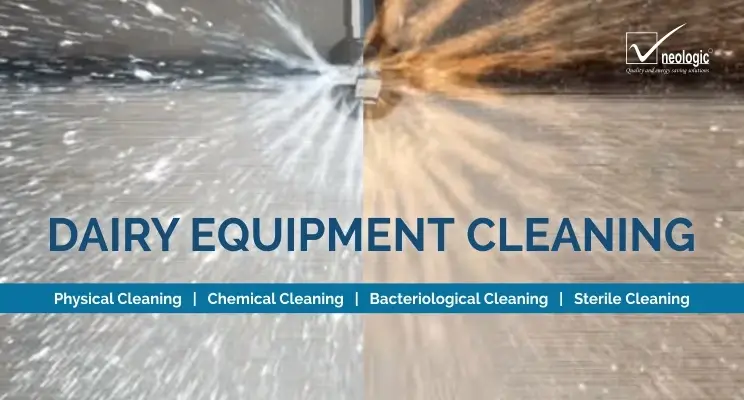
Dairy process equipment cleaning is an essential aspect of dairy production.
The milk collected through cooperatives goes through many channel containers and thus is highly susceptible to bacterial as well as dirt contamination.
The same is true for the manufacturing and production process as well.
Therefore, dairy machinery manufacturers recommend regular cleaning of dairy equipment.
Cleaning Objectives
Cleaning dairy machinery has four degrees involved in it:
- Physical cleaning
- Chemical cleaning
- Bacteriological cleaning
- Sterile cleaning
As cleaning methods intend to achieve both chemical and bacteriological cleaning along with physical and sterile cleaning, the production equipment is therefore subjected to chemical cleaning first, followed by the process of disinfecting.
The Following Are Types of Residues That Need to Be Cleaned From the Dairy Equipment
- Dirt: The dirt in dairy equipment is milk product residues that settle at the bottom of the equipment and have bacteria in it.
- Heated Surfaces:A stone-like deposit consisting of calcium, phosphates, proteins, fat, etc. formulates upon heating the milk at 60 degrees or above temperature. It is generally whitish in colour and changes to brownish colour residue after eight hours.
- Cold Surfaces:After emptying a system, the next immediate step should be cleaning. If not done so, a white film formed at the base will dry and solidify, thus getting harder to be removed. For physical cleaning of surfaces, a special kind of milking machine cleaning brushes is used.
The Process of Cleaning
A few dairy processing manufacturers still use the process of manual cleaning of equipment with detergents and scrubbing. This method is not entirely effective as we have mentioned above that dairy residues vary in nature. Also, the process is time-consuming and very labour intensive. Therefore Dairy Machinery Manufacturers suggest the Cleaning-in-Place or CIP Cleaning System method.
Below mentioned are the 5 steps in the CIP method of cleaning:
Step 1: Recovering Product Residues From the Systems
- It is necessary to remove residues from the production equipment to minimize the loss of products, help in the cleaning process as well as reduce sewage produced.
- All of the products must be allowed to drain from the walls of tanks and pipes. If the surface is coated with solid residue, it should be thoroughly scraped out. The remaining milk either has to be forced out of the production lines with water, blown, or flushed out.
Step 2: Pre Rinse With Water
- Pre-rinsing is the second step in the cleaning procedure and must be done right after the production run.
- Milk fat residues are easy to wash out with warm pre-rinsing water. But one should take care that temperature should not exceed 55-degree Celsius as it may lead to coagulation of protein elements present in the residue.
- Pre-rinsing should be continued until the water exiting the system is completely transparent.
- Around 90% of un-encrusted residues and almost 99% of the total residue can be effectively washed out in the pre-rinsing process. If after washing as well a few particles remain then they can be cleaned using milking machine cleaning brushes.
Step 3: Detergent Cleaning
- The dirt accumulated on hot surfaces is generally washed out with acidic detergents and alkaline followed by intermediate water flushing through the surfaces.
- The residue accumulated on cold surfaces is mostly cleaned with alkalines and at times with acid solutions.
- To achieve good contact between the detergent solutions that contain alkalis; NaOH(caustic soda) and the dirt film, a wetting agent or surfactant should be added. This lowers the surface tension of the liquid. Teepol (alkyl aryl sulphonate) which is an ionic surfactant is typically used.
- The detergents should be able to disperse dirt and encapsulate the suspended particle to avoid flocculation. There are a few things to be kept in mind to ensure excellent results with any detergent solution; concentration of the detergent solution, the temperature of the solution, the mechanical effect on the cleaned surfaces or velocity, and the time duration of cleaning.
Step 4: Another Round of Cleansing With Clean Water
- Once cleaning with the detergent is done, the machinery surfaces must be washed with water thoroughly to remove every bit of detergent.
- Typically For this process, softened water should be used. This, in turn, will prevent the deposition of limescale on the machinery surface.
- Finally, to prevent overnight bacteria formation in the residual cleaning water, the final rinse water should be acidified to a pH of less than 5. It can be achieved by adding phosphoric or citric acid to the water.
Step 5: Disinfecting
- When adequately cleaned with acid and alkaline solutions, equipment gets physically, chemically as well as bacterially clean.
- The process of disinfecting further enhances the bacterial cleansing process.
- For a few products like UHT milk and Sterile milk, sterilisation of equipment frees them from all bacteria that might be present.
- There are two processes of disinfecting dairy equipment, Thermal disinfection, in which hot water, boiling water, and steam are used as well as chemical disinfection where chlorine, iodophors, hydrogen peroxide, etc.
- The disinfectant solution should be thoroughly washed out with water.
Conclusion
Dairy machinery and CIP System manufacturers suggest that each dairy equipment must be thoroughly cleaned and sanitized before the next production process to remove the dirt, impurities, residues, and other harmful material that could hamper the next product. Maintaining the basic level of hygiene and cleanliness is extremely important and mandatory by the law as well.